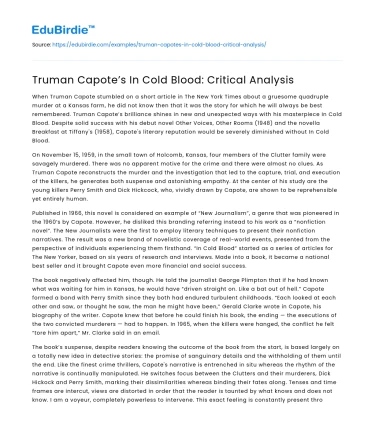When Truman Capote stumbled on a short article in The New York Times about a gruesome quadruple murder at a Kansas farm, he did not know then that it was the story for which he will always be best remembered. Truman Capote’s brilliance shines in new and unexpected ways with his masterpiece In Cold Blood. Despite solid success with his debut novel Other Voices, Other Rooms (1948) and the novella Breakfast at Tiffany's (1958), Capote's literary reputation would be severely diminished without In Cold Blood.
On November 15, 1959, in the small town of Holcomb, Kansas, four members of the Clutter family were savagely murdered. There was no apparent motive for the crime and there were almost no clues. As Truman Capote reconstructs the murder and the investigation that led to the capture, trial, and execution of the killers, he generates both suspense and astonishing empathy. At the center of his study are the young killers Perry Smith and Dick Hickcock, who, vividly drawn by Capote, are shown to be reprehensible yet entirely human.
Save your time!
We can take care of your essay
- Proper editing and formatting
- Free revision, title page, and bibliography
- Flexible prices and money-back guarantee
Published in 1966, this novel is considered an example of “New Journalism”, a genre that was pioneered in the 1960’s by Capote. However, he disliked this branding referring instead to his work as a “nonfiction novel”. The New Journalists were the first to employ literary techniques to present their nonfiction narratives. The result was a new brand of novelistic coverage of real-world events, presented from the perspective of individuals experiencing them firsthand. “In Cold Blood” started as a series of articles for The New Yorker, based on six years of research and interviews. Made into a book, it became a national best seller and it brought Capote even more financial and social success.
The book negatively affected him, though. He told the journalist George Plimpton that if he had known what was waiting for him in Kansas, he would have “driven straight on. Like a bat out of hell.” Capote formed a bond with Perry Smith since they both had endured turbulent childhoods. “Each looked at each other and saw, or thought he saw, the man he might have been,” Gerald Clarke wrote in Capote, his biography of the writer. Capote knew that before he could finish his book, the ending — the executions of the two convicted murderers — had to happen. In 1965, when the killers were hanged, the conflict he felt “tore him apart,” Mr. Clarke said in an email.
The book’s suspense, despite readers knowing the outcome of the book from the start, is based largely on a totally new idea in detective stories: the promise of sanguinary details and the withholding of them until the end. Like the finest crime thrillers, Capote's narrative is entrenched in situ whereas the rhythm of the narrative is continually manipulated. He switches focus between the Clutters and their murderers, Dick Hickock and Perry Smith, marking their dissimilarities whereas binding their fates along. Tenses and time frames are intercut, views are distorted in order that the reader is taunted by what knows and does not know. I am a voyeur, completely powerless to intervene. This exact feeling is constantly present throughout the book, either in the murder of the Clutter family or in Perry and Dick’s execution - or was it a murder too? At the moment the book begins, I am voluntarily carried away by the author and Capote is specially aware of this. For this reason, he builds a bridge in which beginning Perry and Dick look like abominable human beings, but it is not until I have traveled to the other extreme of the bridge when I understand that if I had undergone their childhoods, their failed dreams and their traumas, I would probably have ended up like them. For example, Perry had to endure in his early childhood a terrifying treatment at a orphanage: “There was this one nurse, she used to call me 'nigger' and say there wasn't any difference between niggers and Indians. Oh, Jesus, was she an Evil Bastard! Incarnate. What she used to do, she'd fill a tub with ice-cold water, put me in it, and hold me under until I was blue.” Moreover, he never knew what it was like to be cared and guided by the love of a family: “Perry had on several occasions run off, set out to find his lost father, for he had lost his mother as well, learned to ‘despise’ her.” Capote destroys the label of “monsters” they have been assigned by depicting all those horrendous events that have led them to commit such a crime.
By letting us see the life of these two characters and completely leaving aside the Clutter family, Capote plays with the reader in a majestic way, making it to reconsider class conflicts, mental illnesses and the loss of the “American” Dream”, among many other themes. Although Truman Capote was never the same after the project -digging into such dark territory changed him psychologically and physically,- the literary techniques he pioneered not only are notably crucial in later works such as The Armies of the Night by Norman Mailer and The Electric Kool-Aid Acid Test by Tom Wolfe, but also they guaranteed Capote’s place in the American literary canon.






 Stuck on your essay?
Stuck on your essay?

